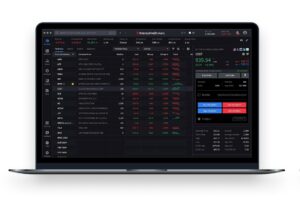As of Thursday’s close, the Dow Jones Index (US30) was down 1.33%. The S&P 500 Index (US500) was up 0.13%. The Nasdaq Technology Index (US100) closed at opening levels. The US stocks closed mixed ahead of the Good Friday holiday as investors weighed trade talks and interest rate uncertainty. A decline in weekly jobless claims indicates a resilient labor market, although attention remains focused on trade talks and monetary policy signals. The US initial jobless claims fell by 9,000 from the previous week to 215,000 in the second week of April, contrary to market expectations of a 1,000 increase to 225,000, the lowest in two months.
Equity markets in Europe were mostly down yesterday. Germany’s DAX (DE40) fell by 0.49%, France’s CAC 40 (FR40) closed down 0.60%, Spain’s IBEX 35 (ES35) lost 0.19%, and the UK’s FTSE 100 (UK100) closed positive 0.01%. Frankfurt’s DAX Index remained in negative territory after the ECB cut rates in an expected move to cushion the economy from tariff-related tensions.
The ECB cut all three key interest rates by 25 basis points, lowering the main refinancing rate to 2.40%, the deposit rate to 2.25%, and the marginal lending facility to 2.65%, as expected. The decision reflects growing confidence that inflation is on track for a sustained return to the 2% target. The ECB acknowledged that growth prospects have weakened and emphasized that further action will depend on the data. European markets will be closed for Easter through Monday and will reopen on Tuesday, April 22.
WTI crude oil prices rose by 3.5% on Thursday to settle at $64.70 a barrel, marking the second straight session of gains. The rise followed new US sanctions targeting Iran’s oil exports, adding to fears of a tightening global supply. The sanctions hit Iran’s oil sector and a refinery in China, increasing pressure on Tehran amid nuclear tensions. Supply concerns were further heightened after OPEC+ said it had received updated plans from Iraq, Kazakhstan, and other countries for additional production cuts.
Asian markets were predominantly up yesterday. Japan’s Nikkei 225 (JP225) gained 1.35%, China’s FTSE China A50 (CHA50) climbed 0.20%, Hong Kong’s Hang Seng (HK50) rose by 1.61%, and Australia’s ASX 200 (AU200) gained 0.78%. The recovery in Asian indices followed a rise in US futures after President Trump claimed “great progress” in talks aimed at helping Japan avoid a tariff hike. Investor sentiment was also boosted after Chinese President Xi Jinping called for regional unity and the creation of an “Asian family” during his tour of Southeast Asia.
The New Zealand dollar fell to US$0.593 on Friday, retreating from a five-month high and snapping a seven-day winning streak, as expectations of further easing by the Reserve Bank of New Zealand dampened momentum. This came despite stronger-than-expected first-quarter consumer inflation data, while core inflation figures declined. With price pressures contained and remaining within the RBNZ’s target range, markets still expect a rate cut in May and a reduction in the cash rate to 2.75% by the end of the year.
The Australian dollar slid to US$0.637 on Friday, breaking a seven-day winning streak in thin trading as local markets were closed due to the Good Friday holiday. The decline followed weaker-than-expected domestic employment data earlier in the week, which reinforced expectations of further monetary easing by the Reserve Bank of Australia.
Malaysia’s economy grew by 4.4% year-on-year in Q1 2025, compared to growth of 5% in the previous quarter. This is the slowest growth rate in a year, driven by weaker growth in services (5.2% vs. 5.4% in Q4), construction (14.5% vs. 20.7%), and manufacturing (4.2% vs. 4.4%). In quarterly terms, the economy contracted by 3.7% after growing by 2.7% in Q4.









